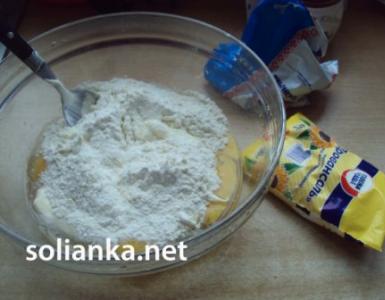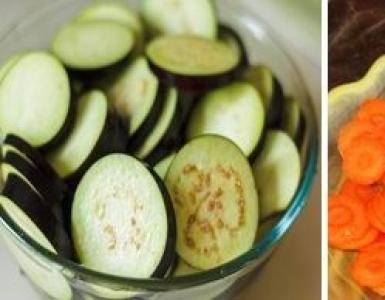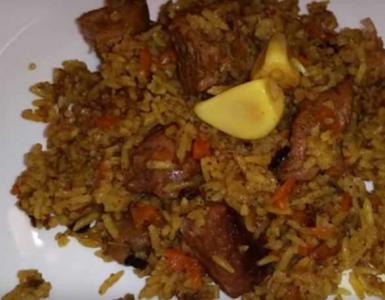Baked boar's knee - a recipe for baked pork knuckle in Czech style. How to cook boar's knee: recipe with a side dish of stewed cabbage Pork knee in Prague
The girls liked the manipulations that cooks in the Czech Republic (not to be confused with orthopedists!) do on the joints of all kinds of pigs so much that they asked me to repeat the procedure. Like, you have a higher medical degree - here’s a ladle in your hands, and a kitchen at your disposal - own it!
I had to raid local markets in search of what I needed. In principle, the license for autumn hunting was already in my pocket, but I made do with a kind word and a wallet. A couple of pork knuckles (although we cut them exactly at the joint, which, in a good way, should be in the middle of the piece in this dish), cumin, rosemary, some kind of horseradish (perhaps even from the hillock), several green apples, carrots, onions, ginger, cloves, allspice, a few leaves from someone's laurel wreath, garlic, honey, dark beer... do you remember everything? It seems that the main thing is yes, the rest was at home.
To be honest, there are probably as many recipes for baked boar’s knee in the Czech Republic as there are recipes for borscht in our country. Or somewhere in Central Asia - pilaf recipes. And everyone probably considers their own recipe the most authentic and correct. Therefore, what I will now show you is just one of many options. Relatively fast and lazy (although it will still take several hours of time). We simply grabbed the cook from the Strahov Cluster by the... hmm... apron and did not let go until he remembered everything that connects him with these wonderful joints. And then we chose the option that suited the situation.
So, having chopped apples and carrots into large pieces, chopped a few cloves of ginger (in principle, an optional, but very good addition to the taste), I put everything in a large saucepan and, adding a teaspoon of cumin, a pinch of rosemary, a dozen allspice peas, four cloves, a few whole onions and a bit of marjoram, placed shanks on top of all this eclectic salad. Oh yes, and add a little salt.

Having wiped away the stingy tears of the experienced gambrinist, he poured dark beer into the pan so that it almost covered the entire still life.

Then I set it to cook for two and a half hours. It would have been possible for three, but my girls said that they could not stand an extra hour of torture with delicious smells from the pan.

After a couple of hours, the softened and fairly intoxicated shanks were removed from the pan, slightly cooled and sobered in the fresh air and rubbed with such a mixture (a couple of tablespoons of honey, a tablespoon of mustard, a couple of heads of garlic ground into a paste and - as my personal improvisation - half a teaspoon spoons of smoked chipotle pepper and half a teaspoon of smoked paprika powder). The soy sauce with which the sauce was diluted probably used to replace the broth in which the shanks were cooked, but oh well, let’s not resist globalization.


The vegetables and apples that remained after cooking could have been chopped with a couple of spoons of broth in a blender and used as a sauce, but in the end we never got around to it. But we saved the broth - it would be great to stew meat in.
And then - everything goes to hell. That is, into the oven. For an hour. At 180-200 Celsius. I had to check in every 15 minutes to see how it was in general? Shouldn't it be greased with rendered fat to make the crust crunchy?
And then... Then both pieces went under, under white bread and under beer (in the children's version - under kvass).

In general, we took this recipe into service. I repeat: this is not the only recipe, there are many, but we tested this one and intend to repeat it.
The Czech dish Vepřové koleno means boar's knee or simply pork knuckle (Vepř - young wild boar). This dish is the pride of Czech cuisine and the decoration of any table. It must be served in 1 large piece weighing from 1 kg on 1 dish. It comes with side dishes of vegetables, as well as various sauces. It is recommended, of course, to wash down such a hearty dish with beer.
To prepare this dish, the back of the pork leg is used, as it is meatier and larger than the front.
The cooking process is long but simple. First the shank is boiled, then baked.
It is better to boil it in dark beer; you will get a more flavorful piece of meat. Although you can just do it in the water. The duration depends on the desired softness. Usually it is 2-3 hours. Before baking, the shank is coated with either soy sauce, honey-mustard sauce, or just honey, and then baked in the oven until a crust forms.
Traditionally, stewed cabbage or mashed potatoes are used as a side dish. Additionally, several sauces and sour cucumbers are served.
We will prepare traditional pork knuckle with stewed cabbage. Highly recommended for cooking
My recipe today has a very beautiful name: baked boar's knee in Czech style. Doesn’t it sound very appetizing and tasty? This is actually true: boar's knee is a shank that is cooked in beer, with spices, and it turns out simply incredible! We, of course, are not in the Czech Republic, but we can easily afford to prepare such deliciousness. Moreover, it is not at all difficult, although it takes quite a long time - more than two hours.
But believe me, the result is worth waiting for so long. The meat turns out very tender, aromatic and tasty. And you can serve it either immediately, hot or cold; some people even like it this way.

This knuckle is a very sociable dish; it will be great if you invite your friends over for a couple of glasses of beer and serve boar’s knee in Czech style: believe me, everyone will be absolutely delighted.
Ingredients:
- 1.5 – 2 kg pork knuckle;
- 2 liters of beer;
- 1 medium sized carrot;
- 1 medium sized onion;
- 1 bay leaf;
- 5-6 cloves of garlic;
- 2 peas of allspice;
- 6-8 black peppercorns;
- 1-1.5 tablespoons of hot table mustard;
- 1 teaspoon pepper mixture;
- 2 tablespoons and 1 teaspoon of salt.
How to cook boar's knee in Czech:
Carefully clean the skin of the shank with a knife. At the same time, we try not to damage the skin. If there is stubble left in hard-to-reach places, singe it over the burner. Rinse the knuckle thoroughly with cold running water.

Place the shank in a wide pan and fill with beer. It is advisable that the shank be completely covered with beer. If a very small piece protrudes from the beer, you can leave it that way. If the knuckle protrudes by about 1/3, you should cut it into 2 parts. Of course, in this case the appearance of the finished shank will suffer, but if you do not have a pan of the appropriate size, you will have to do so. Place the pan with the shank on the stove and bring to a boil over high heat.

Peel the onions and carrots. Wash them thoroughly.

Remove the foam, add onions and carrots. Add 2 tablespoons of salt (without top), black and allspice peas, bay leaf. Bring the liquid to a boil again over high heat.

Then reduce the heat and cook the shank for 1 hour. Then carefully turn the shank over in the pan and continue cooking for another 1 hour. By the end of cooking, the shank is almost ready.

Now let's get ready to bake the boar's knee in the Czech style in the oven. Peel the garlic and rinse it. Cut each clove in half lengthwise. Carefully remove the knuckle from the water. Making cuts 2-3 cm deep with a narrow knife, stuff the shank with garlic, trying to distribute it evenly. Sprinkle the shank with the pepper mixture and the remaining teaspoon of salt, rub the salt and pepper over the entire surface. Spread the mustard and rub it over the entire surface.

Transfer the shank to a baking dish.
And excellent national cuisine. Czech cuisine is surprisingly diverse - various soups, cold appetizers, cheeses, delicious sweet pastries and, of course, meat dishes. Meat is one of the main and traditional products on the Czech table. The most commonly used meat dishes in the Czech Republic are pork, beef, rabbit and venison. Meat is prepared in different ways: it is fried, stewed, marinated and baked. All cooking methods contain a combination of various seasonings, which gives the meat an unsurpassed taste and aroma. The most popular national Czech meat dishes are goulash soup, brawn and Prague ham. But the most famous Czech meat dish is Boar's Knee (Pečené vepřové koleno), which, thanks to its taste, deserves the title of the king of Czech dishes.
A little history of the “Boar’s Knee”

The history of the "Boar's Knee" dates back to the 11th century, in the medieval tradition of roasting meat after a hunt. Hunting was one of the favorite pastimes of the aristocracy of that time; after the hunt, huge feasts were always held, the main dish of which was the catch. Traditionally, they prepared “Boar's Knee” - the left leg of a shot wild boar was cut off and baked, after soaking it in a marinade. This recipe has passed through hundreds of years, and “Boar’s Knee” has not lost its relevance and popularity in the modern world, however, now “Boar’s Knee” is often prepared from ordinary pork knuckle.
How to prepare and what to serve with “Boar’s Knee”
You can find various recipes for preparing Boar's Knee, but the traditional method is to cook it in dark aromatic beer. For “Boar's Knee”, choose a large piece of pork shin with part of the thigh and be sure to use aromatic spices: black and allspice, garlic, ginger, nutmeg, coriander, celery and parsley.
There are also recipes for preparing “Boar's Knee” with the addition of honey and sour apples. The technology for preparing the dish is simple: the meat is washed, dried, garlic is placed in small cuts, salted and sprinkled with seasonings; the prepared meat is poured with beer and left to marinate in a cool place for 12 hours to a day; meat soaked in spices and beer is sent to the oven.

The traditional Czech Boar's Knee is a dish in itself; it is usually served with fresh bread, horseradish and mustard. However, often “Boar's Knee” is served not only with sauces, but also with side dishes. Usually it's potatoes or stewed cabbage.
How much does Boar's Knee cost in Prague?
 It is simply impossible to visit Prague, walk around and not try delicious national Czech dishes. An incredible number of restaurants, cozy cafes and pubs will offer you to taste goulash and, of course, “Boar’s Knee”.
It is simply impossible to visit Prague, walk around and not try delicious national Czech dishes. An incredible number of restaurants, cozy cafes and pubs will offer you to taste goulash and, of course, “Boar’s Knee”.
In Prague restaurants, the price of a traditional “Boar's Knee” fluctuates around 200 Kč. The cost of the dish will depend on the weight of the portion, the level of service and the location of the establishment where you are going to dine. So 800 grams of “Boar's Knee” in one of the famous Prague restaurants “U Cejpu” will cost about 170-180 Kč, a dish weighing more than 1 kg will cost a little more - 200-215 Kč. The restaurant "U zlate konvice", located in the very center of the historical part of Prague - a stone's throw from, offers "Boar's Knee" for 500 Kč.
Small brewery restaurants will delight you with reasonable prices and delicious traditional dishes. One of these mini-restaurants called “Pivovarsky dum”, located next to, will offer you a taste of “Boar’s Knee” for 215 Kč.
Cooking "Boar's Knee" at home
 Do you want to cook Boar's Knee yourself? There's nothing complicated about it. The following ingredients are needed for the dish:
Do you want to cook Boar's Knee yourself? There's nothing complicated about it. The following ingredients are needed for the dish:
- 2 pork knuckles;
- 400 ml of dark beer;
- 100 ml water;
- 10 cloves of garlic;
- 1-2 onions;
- 5 tablespoons mustard;
- a couple of tablespoons of flour;
- salt.
You will also need bay leaf, ground allspice, black peppercorns, cumin, fresh horseradish, prepared on a grater.
Prepare Boar's Knee like this:
- Free the pork leg from the bones, rub salt, mustard, spices and garlic into the meat.
- Roll up and secure with rope.
- Place the meat on a baking sheet and sprinkle with caraway seeds, onions, and the remaining seasonings, add a bay leaf, pour in beer and cover with foil.
- Bake for 1-1.5 hours at 180°C. During cooking, water is added to the meat and beer is also poured over it. The bright golden color and softness of the meat indicates the readiness of the dish.
After preparing the Boar's Knee, pour the sauce into a frying pan and add a little flour. Carefully remove the string from the meat. Before serving, “Boar Knee” is poured with the resulting sauce. Served as a separate dish or with a side dish. And “Boar's Knee” is always accompanied by mustard and freshly prepared horseradish.

“Boar Knee” has an appetizing appearance, great taste and aroma. Having tried this dish in one of the many Prague restaurants or cozy cafes, you will surely become not only a gourmet, but also a gourmet of Czech national cuisine.
Czech cuisine was formed in accordance with local culinary preferences and numerous borrowings. It is distinguished by hearty dishes and juicy-sweet desserts. The most typical dish of Czech cuisine is baked pork knuckle, or Rečené vepřové koleno in Czech.
The motto of Czech cuisine is maximum satiety, so that you can fill up with one dish if it can replace the first, second and third along with dessert.
The Czechs pride themselves on creating a wide range of "one big piece of meat" dishes and recipes, and the real king of the local culinary tradition is the "baked boar's knee" - a pork knuckle weighing a kilogram or more, first marinated in beer and then baked. It is usually served with horseradish, mustard, sauerkraut and pickled peppers. Every tourist should try boar's knee.
The history of this masterpiece of Czech cuisine goes back to the distant Middle Ages, when to prepare baked knuckle in Czech style, the left front leg was cut off from a wild boar that had just been shot in the nearby forest. Today, Czechs prepare boar knee not from wild boar, but from ordinary pork knuckle, but, nevertheless, this dish is considered by many to be the crowning achievement of Czech cuisine.
The original recipe uses the knee of a real boar, but it is unlikely that even the Czechs have preserved the custom of hunting a real wild and ferocious boar before dinner, so it is boldly replaced with an ordinary, domesticated one, but no less ferocious.
Boar's knee is a very nourishing and very tasty dish, it is prepared simply, but takes quite a long time and is always in large quantities. In the Czech Republic, depending on the level of generosity of the establishment, they will bring you a portion from 1 to 1.5 kilograms, so when ordering such a dish you can safely count on 3-4 people.
Meat selection
It is best to take a piece that would capture part of the lower leg and part of the thigh, with the knee itself being in the middle. Then the dish cannot be called dry or bony, and there will be much more meat left in its pure form.
Pork knuckle, like many other meat dishes, can be different: knuckle with stewed cabbage and potatoes, pork knuckle in beer with boiled potatoes, pork knuckle baked in the oven, pork knuckle baked on tangerines, the German version - icebein and even shank marinated in Coca-Cola. Boar's knee can also be served as a first course; for example, pork knuckle makes an excellent bean soup.
Classic recipe
Ingredients: pork knuckle, 1.5-2 liters of light beer, 4 cloves of garlic, 15 allspice peas, 10 black peppercorns, ginger root, half a nutmeg, 2 bay leaves, 2 sour apples, 100 g honey, 50 ml soy sauce, salt , coriander, parsley and celery to taste.
Cooking method. Rinse the knuckle thoroughly and dry with a paper towel. Peel the garlic and cut into thin slices. Make small cuts in the meat and place the garlic there. Mix salt and pepper in a 2:1 ratio and rub the shank with the resulting mixture. Place the washed herbs, peppercorns, nutmeg and bay leaf in a large saucepan. Peel and cut the ginger root into thin slices and place on top. Place the shank in a saucepan and pour in beer. Wash the apples, remove peels and seeds, add to the meat, and leave to marinate for a day.
Take out the shank, wrap it in foil and bake for about 2 hours in an oven preheated to 250 degrees. Serve with fresh or pickled vegetables, or stewed cabbage.
You can also add herbs, horseradish and sweet mustard to the dish, which are mixed together and used as a spicy seasoning. And, if desired, beer.













